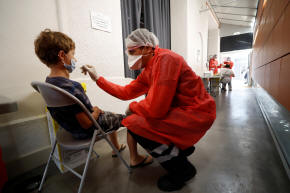Coronavirus may be linked to cases of severe hepatitis in children
 Send a link to a friend
Send a link to a friend
 [May 17, 2022]
By Nancy Lapid [May 17, 2022]
By Nancy Lapid
(Reuters) - The following is a summary of
some recent studies on COVID-19. They include research that warrants
further study to corroborate the findings and that has yet to be
certified by peer review.
SARS-CoV-2 could be at root of mysterious hepatitis in kids
A chain of events possibly triggered by unrecognized infection with the
SARS-CoV-2 coronavirus could be causing the mysterious cases of severe
hepatitis reported in hundreds of young children around the world,
researchers suggest.
Children with COVID-19 are at significantly increased risk for liver
dysfunction afterward, according to a report posted on Saturday on
medRxiv ahead of peer review
https://www.medrxiv.org/content/
10.1101/2022.05.10.22274866v1. But most of the children with acute
hepatitis - which is generally rare in that age group - do not report a
previous SARS-CoV-2 infection. Instead, the majority have been found to
be infected with an adenovirus called 41F, which is not known to attack
the liver. It is possible that the affected children, many of whom are
too young to be vaccinated, may have had mild or asymptomatic COVID
infections that went unnoticed, a separate team of researchers suggest
in The Lancet Gastroenterology & Hepatology
https://www.sciencedirect.com/
science/article/pii/S2468125322001662.

If that were true, they theorize, then lingering
particles of the coronavirus in the gastrointestinal tract in these
children could be priming the immune system to over-react to
adenovirus-41F with high amounts of inflammatory proteins that
ultimately damage the liver.
"We suggest that children with acute hepatitis be investigated for
SARS-CoV-2 persistence in stool" and for other signals that the liver
damage is happening because the spike protein of the coronavirus is a "superantigen"
that over-sensitizes the immune system, they said.
Face-down position unhelpful for awake patients
[to top of second column]
|

A firefighter from the Marins-Pompiers of Marseille (Marseille Naval
Fire Battalion) administers a nasal swab to a child at a testing
site for coronavirus disease (COVID-19) in Marseille, France,
September 17, 2020. REUTERS/Eric Gaillard
 For hospitalized COVID-19 patients
who are breathing on their own but with supplemental oxygen, lying
face down might not help prevent them from eventually needing
mechanical ventilation, according to a new study.
In the study, 400 patients were randomly assigned
to usual care or to standard care plus intermittently lying on their
stomach, a position known to improve the course of illness in
sedated patients on mechanical ventilators. Over the next 30 days,
34.1% in the prone-positioning group and 40.5% in the usual-care
group needed to be intubated and put on a ventilator, a difference
that was not statistically significant. There might have been a
reduction in the risk for intubation with prone positioning among
some of the patients, researchers said on Monday in JAMA
https://jamanetwork.com/journals/
jama/fullarticle/2792506, but they could not confirm it
statistically from their data. The average duration of prone
positioning per day was roughly five hours, less than the target of
eight to 10 hours per day.
"Long hours of awake prone positioning are challenging and highly
influenced by patient comfort and preference," the researchers said.
"The most common reason for interruption of prone positioning was
patient request, which might have been related to overall subjective
improvement or related to discomfort from prone positioning."
Click for a Reuters graphic https://tmsnrt.rs/3c7R3Bl on vaccines in
development.
(Reporting by Nancy Lapid and Megan Brooks; Editing by Bill Berkrot)
[© 2022 Thomson Reuters. All rights
reserved.] This material may not be published,
broadcast, rewritten or redistributed.
Thompson Reuters is solely responsible for this content. |